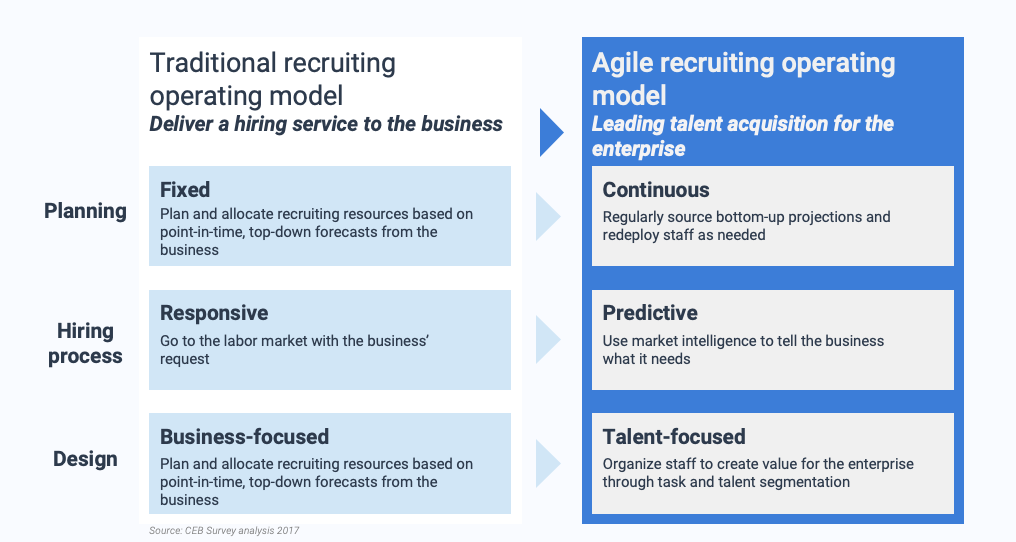
Blog
Agile Recruiter
Urszula Czekirda 06.03.2023
Agile – How Exactly?
Agile is a methodology originally used in software development. It focuses on exchanging regular feedback from and between key project stakeholders to identify changes in the process, make business decisions, and achieve better outcomes. Simple, right? It might seem that we have always worked this way. Or perhaps this is how we should work, but not necessarily how we do?
So, What is an Agile Recruiter?
Two items on every recruiter's wishlist are more efficient processes and the ability to continually hire the right candidates. To achieve these goals, it’s important to have the right workflows, teams, and tools that will turn this wishlist into reality. Implementing and maintaining these three key pillars of recruitment can be challenging. Agile recruitment aims to make recruitment better aligned with business needs, making the entire process less risky and more efficient. In the context of recruitment, risk refers to the quality of hiring and the associated resources and costs. Agile recruitment achieves these goals by creating cyclic frameworks for hiring that include regular feedback, communication, and the refinement of processes and results.
In agile project execution, tasks are divided into periods of "sprints". Team members work on the tasks assigned to them within these sprints, which make up the entire project. At the end of the sprints, the team organizes retrospective meetings and progress reviews. This action is key as it provides insight into progress, draws conclusions, and introduces corrective actions (remember the basic functions of management and Kaizen?).
How to be Agile in Recruitment?
Agile recruitment can't happen without the right team. In fact, the team is as important as the process itself. Everyone involved in the recruitment cycle has clearly defined roles and responsibilities. Translating agile positions into recruitment, we find:
-
Hiring Manager or HR Business Partner/HR Manager: Acts as the project owner, representing the company's needs.
-
Scrum/Agile Master: Main task is to design the work process and keep it on the right track. In recruitment, this is often the Team Leader of the recruiting team.
-
Recruiters and Sourcers: Execute the process, refine workflows, and achieve desired outcomes.
Technology is the last piece of the puzzle, allowing us to close the project holistically and with the best results. Utilizing Applicant Tracking Systems (ATS), analyzing LinkedIn Recruiter, or any other tool as part of agile recruiting provides access to a treasure trove of historical data and analyses about what has worked and what hasn't in previous recruitment cycles. Adding Kanban boards, which can be used for assigning and tracking task progress, and 1-on-1s to achieve broader reach and enable continuous communication, even with a distributed team, ensures that the flow of information is good enough to quickly catch any noise and implement corrective actions.

source: https://beamery.com/resources/blogs/agile-recruiting-why-ta-needs-a-new-operating-model
What Can I Gain from Agility in Recruitment?
Properly and regularly conducted agile recruitment can bring benefits in terms of efficiency, quality of hire, candidate experience, and team cohesion. By constantly analyzing and correcting mistakes, we continuously improve the strategy of the recruitment process in the company, overcoming repetitive problems that cause time losses. This results in lower hiring costs and better utilization of the team and their resources.
The transparency of the process allows for regular visibility and two-way communication about progress, goals, results, and the processes used for hiring new candidates. In such a sterile environment, it's easier to prioritize actions and introduce a culture of open feedback within the team.
A consistent, logical, and transparent process undoubtedly positively affects the so-called candidate experience, which of course improves the company's image.
Do I Need This?
If you're struggling with one or more of the following problems:
- Talent shortages,
- Long hiring processes,
- Lack of data-driven strategies,
- High candidate dropout rates from the process,
- High turnover of new employees,
it means it's time to rethink your recruitment process. Well-structured agility helps overcome these challenges, creating frameworks for communication and project management that maximize efficiency, minimize resource wastage, and allow for continuous improvement.
What Does an Agile Cycle Look Like in Recruitment?

source: https://simonjamesgroup.com/agile-recruiting/
1. Defining the Candidate Persona and Drafting the Job Description - ANALYSIS OF NEEDS
Most companies make a fundamental mistake at the beginning of every recruitment process. We focus on defining the tasks for the position, the necessary competencies, and the value the company can offer to candidates. However, we often overlook the importance of building a candidate persona. Who is this? In simple terms, it's a representative of the target group. Carefully defining, visualizing, and outlining their characteristic features allows us to recruit talents that will perfectly complement our team (and no, a persona is not equal to standardizing the team according to a uniform pattern - on the contrary! A persona should be created separately for each position based on the competencies, characteristics, and values we need at the moment, depending on the technical needs and soft skills the team is looking for more efficient operation).
2. Building an Agile Recruitment Team - CREATING A RESOURCE
After setting the goal, it's time to assemble the team. For the whole machine to work correctly, each of its elements must know exactly what role it plays, which is why clear communication and an official organizational structure are so important. Openly define who will play the role of project owner and leader. These will be the people responsible for implementing the project and determining whether it ended in success or failure.
Your project leader should then choose their team to carry out the project. This will typically include a recruiter, sourcer, and, depending on the size of the organization, possibly additional "assistants."
Having a team - it's time for a meeting, where we outline the GOAL (along with defining the persona, their role in the organization, must-haves and nice-to-haves, but also the vision for their development in the organization or the results that their employment will bring to the company), EXPECTATIONS, COMMUNICATION FLOWS. This gives everyone clear information, allowing them to start their actions.
3. The Acquisition Stage
This is where we start a series of sprints. It's a big cycle that requires a good division of responsibilities and regular feedback from the entire team. Mistakes at this stage will always result in later disappointments regarding candidates or, worse, the hired person.
This stage is divided into at least four sprints (you should estimate the length depending on the difficulty of the process):
- Building the announcement
- Publication of the offer
- Direct search and sourcing of passive candidates
- Collecting incoming and existing contacts
Each stage should include meetings during which we analyze obstacles, introduce improvements, and assess our progress.
For example, after writing and posting recruitment ads, you can organize a review session to look at the incoming candidates you've received and whether they reflect your ideal candidates. If not, it's an opportunity to refine your outreach strategy. If you don't do this at this stage, you can be sure that you won't find the perfect talent, and what you'll get is a huge waste of time, frustration from rejected candidates, declining morale among recruiters, and a business that's watching the clock.
In addition to incoming candidates, whether from active flows or direct search, agile recruiting often utilizes ready-made talent pools containing qualified candidates. These are pre-screened candidates with whom the recruitment team has made contact through earlier networking and outreach activities. These candidate databases are a great way to enable "Just In Time" recruitment, which shortens the length of the recruitment process (I encourage you to read about Toyota's management model).
4. Selection Stage
This phase of the agile recruitment cycle is the moment when you can formally and tangibly see how well your candidate acquisition strategy worked. Together with the team, you should analyze the first few candidate profiles and compare their fit with the recruitment goal.
How to analyze them? Here comes the famous CV screening or the first interviews with candidates.
If the fit is consistent - great, continue! If not, this is another ideal time to make changes before they become more energy and cost-intensive.
5. Check, Reject/Accept, and Provide Feedback
This stage is a continuation of the previous step and gives your team another opportunity to review sourcing and screening processes.
Conduct interviews with candidates who meet your criteria and continue refining your “shortlist.”
Again, discuss interview outcomes with the agile team to gauge how well or poorly your strategy is working.
If you can offer a candidate a job, then you can consider the selection part of the project complete. If not, it's probably time to return to the third step and refine your strategy.
Feedback - we probably don't need to analyze this, right? I'll just add that building an employer brand and our reputation as recruiters should always be a priority. After all, this is one of the elements of creating a database of potential future candidates…
6. Evaluate Recruitment Results and Adjust the Process if Necessary
Now, the most crucial part: The work isn't finished after hiring a candidate!
To close the agile recruitment process, it's important to check how well the candidate performs and fits the original organizational goal over time. It's also vital to review key performance indicators to determine if the hiring process was as effective as intended.
The goal is to continuously analyze and reflect on the hiring process and its outcomes to find areas for improvement.
In an agile recruitment environment, all the above steps are carried out within a sprint. Each would be treated as an incremental element that includes initiation, execution, and reflection through daily/weekly meetings or as you prefer.
As a result of this commitment to feedback and continuous improvements, agile recruitment provides a wide range of benefits for hiring teams, contributing to a progressively more efficient process each time. More efficient means:
- Faster,
- More accurate in terms of matching the candidate to the role,
- More pleasant and professional for the candidate,
- Cheaper for the business,
- Easier to implement for the team.